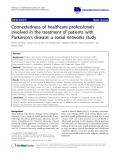
143
HNUE JOURNAL OF SCIENCE
Social Sciences 2024, Volume 69, Issue 4, pp. 143-149
This paper is available online at https://hnuejs.edu.vn
DOI: 10.18173/2354-1067.2024-0076
POLITICAL COMMUNICATION ON SINA WEIBO SOCIAL NETWORK
IN CHINA AND IMPLICATIONS FOR VIETNAM
Nguyen Thi Xiem
Faculty of Education, Hanoi Metropolitan University, Hanoi city, Viet Nam
Corresponding author: Nguyen Thi Xiem, email: ntxiem@daihocthudo.edu.vn
Received November 7, 2024. Revised November 13, 2024. Accepted November 22, 2024.
Abstract. With the development of technology, political propaganda on social media has
received increasing attention from countries around the world. In China, this activity is more
efficient in reaching a large number of people at a faster rate than traditional forms of
propaganda. This study aims to analyze political communication activities on China's Sina
Weibo social network and propose some implications for Vietnam. The study uses a
document collection and analysis method to collect relevant documents from 2016 to 2024,
including official documents, academic works, and policies of the Communist Party of China.
Descriptive statistics are used to investigate the current situation of social media use in both
Vietnam and China in 2023. Then, a comparative analysis is conducted to identify similarities
and differences in political communication activities between the two countries. From the
findings of the study, the author suggests some key recommendations for Vietnam.
Keywords: political propaganda, social networks, China, Vietnam.
1. Introduction
In China, political communication has received special attention from the Chinese
Communist Party (CCP) and the State. In addition to traditional media channels such as print, radio,
and television, famous social media platforms like Sina Weibo, online social forums, websites, etc.
are increasingly being invested in and developed by the Party and the Chinese government.
According to data from the China Internet Network Information Center, until June 2023, the
number of Internet users reached 1.079 billion, recording an increase of 11.09 million compared
to that in December 2022 [1]. Among these platforms, Sina Weibo is one of the most popular
social media networks in China. Since Facebook and Twitter were restricted in China, Weibo was
created as a replacement for these applications, with 586 million monthly users, of which 252
million interact daily [2]. Weibo is used not only by ordinary users but also by famous artists, the
media, and government agencies or businesses due to its strict verification process. The CCP and
Government have taken advantage of the popularity of this platform to reach many Chinese
citizens conveniently. This requires the CCP to implement political communication on social
media, including Weibo, to the people. At the Cybersecurity and Information Work Conference,
General Secretary and President Xi Jinping emphasized, “Wherever the people are, our leaders must
come”. If political communication on social media is done well, it will significantly enhance China's
cultural power and even make outstanding contributions to the political civilization of humanity.
This issue has attracted interest from scholars worldwide. Notable examples include Sun
Jiaxu with the study “Research on the Application of Social Media in Political Ideological






























